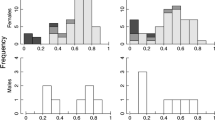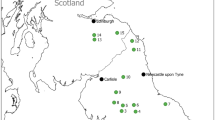Abstract
Two recent studies on territory occupancy rates of goshawk Accipiter gentilis and gyrfalcon Falco rusticolus report a 2–3-year-delayed numerical response to grouse numbers, which is a requirement for a hypothesis of predator-generated grouse cycles. The time lags were assumed to reflect the average age of sexual maturity in the raptor species. In southern Norway, however, subadult (two-year-old) goshawk hens occupied only 18–25% of territories where occupancy was not recorded in the preceding year, and there was no significant relationship between the proportion of subadults among recruits and grouse indices two years earlier. We argue that territory occupancy rates are not appropriate indices of total raptor population levels, but rather reflect the proportion of territorial pairs that attempt to nest. Because this depends on the body condition of the hens, fluctuations in other important winter resident prey species (most important for the goshawk) and winter weather (most important for the gyrfalcon) should also be addressed. During 1988–2006, the annual proportion of goshawk territories with recorded nesting attempts in southern Norway was most closely related to the preceding autumn’s population indices of black grouse Tetrao tetrix and mountain hare Lepus timidus, whereas the annual proportion of gyrfalcon territories with observations of falcons or with confirmed breeding attempts in central Norway were best explained by population indices of willow grouse Lagopus lagopus and ptarmigan L. mutus from the previous autumn, and by December temperatures. Hence, our studies do not support the predation hypothesis for grouse cycles.


Similar content being viewed by others
References
Andrén H, Lemnell P-A (1992) Population fluctuations and habitat selection in the Eurasian red squirrel Sciurus vulgaris. Ecography 15:303–307
Brynjarsdóttir J, Lund SH, Magnússon KG, Nielsen ÓK (2003) Analysis of time series for rock ptarmigan and gyrfalcon populations in north-east Iceland (report RH-18-2003). University of Iceland, Reykjavík, Iceland
Fairhurst GD, Bechard MJ (2005) Relationships between winter and spring weather and Northern Goshawk (Accipiter gentilis) reproduction in Northern Nevada. J Raptor Res 39:229–236
Fimreite N (1977) Acid rain and declining population of forest grouse. Foredrag Nordisk Skogsfuglsymposium 1976. Viltrapport 5:82–91 (In Norwegian, with English abstract)
Fischer W (1980) Die Habicht. Die Neue Brehm-Bücherei, Wittenberg, Lutherstadt
Framstad E (ed) (2004) Monitoring programme for terrestrial ecosystems. Ground vegetation, epiphytes, small rodents and birds at the monitoring sites, 2003. NINA Oppdragsmelding 839 (In Norwegian, with English abstract)
Framstad E, Kålås JA (eds) (2005) Monitoring programme for terrestrial ecosystems. Small rodents and birds at the monitoring sites, 2004. NINA Report 51 (In Norwegian, with English abstract)
Hagen Y (1952) Rovfuglene og viltpleien. Oslo, Gyldendal (In Norwegian)
Haukioja E, Haukioja M (1970) Mortality rates of Finnish and Swedish goshawks (Accipiter gentilis). Finn Game Res 31:13–20
Helle P, Wikman M (2003) Riistakolmiolaskentojen talven 2003 tulokset. Riistantutkimuksen tiedote 186:1–21 (In Finnish)
Höglund NH (1964) Der Habicht Accipiter gentilis Linné in Fennoskandia. Viltrevy 2:195–270
Huhtala K, Sulkava S (1981) Environmental influences on goshawk breeding in Finland. In: Kenward RE, Lindsay IM (eds) Understanding the goshawk. International Association for Falconry and Conservation of Birds of Prey, Oxford, UK
Kenward RE, Marcström V, Karlbom M (1999) Demographic estimates from radio-tagging: models of age-specific survival and breeding in the goshawk. J Anim Ecol 68:1020–1033
Kostrzewa A, Kostrzewa R (1990) The relationship of spring and summer weather with density and breeding performance of the buzzard Buteo buteo, goshawk Accipiter gentilis and kestrel Falco tinnunculus. Ibis 132:550–559
Krüger O (2005) Age at first breeding and fitness in goshawk Accipiter gentilis. J Anim Ecol 74:266–273
Langvatn R (1977) Characteristics and relative occurrence of remnants of prey found at nesting places of gyrfalcon Falco rusticolus. Ornis Scand 8:113–125
Lindén H (1981) Hunting and tetraonid populations in Finland. Finnish Game Res 39:69–78
Link H (1986) Untersuchungen am Habicht (Accipiter gentilis), vol 2. Deutscher Falkenorden Schriftenreihe, Blomberg, Germany
Marcström V, Kenward R, Karlbom M (1990) Duvhöken och dess plats i naturen. Vidar Marcström Forlag, Uppsala (In Swedish)
Newton I (1979) Population ecology of raptors. Poyser, London
Newton I, Marquiss M (1981) Effect of additional food on laying dates and clutch sizes of Sparrowhawks. Ornis Scand 12:224–229
Nielsen JT (1986) Duehøgen (Accipiter gentilis) i Vendsyssel 1977–85. Accipiter 3:133–174 (In Danish)
Nielsen ÓK (1991) Age of first breeding and site fidelity of gyrfalcons. Náttúrufrædingurinn 63:29–37 (In Icelandic with English summary)
Nielsen ÓK (1999) Gyrfalcon predation on ptarmigan: numerical and functional responses. J Anim Ecol 68:1034–1050
Nielsen ÓK (2004) Gyrfalcon studies in Iceland 1981–2004: proceedings from the Gyrfalcon Workshop, 28 September 2004. The Nordic Working Group on Gyrfalcon, Umeå, Sweden, pp 5–7
Nielsen ÓK, Cade TJ (1990) Seasonal changes in food habits of Gyrfalcons in NE Iceland. Ornis Scand 21:202–211
Nyström J, Dalén L, Hellström P, Ekenstedt J, Angleby H, Angerbjörn A (2006) Effect of local prey availability on gyrfalcon diet: DNA analysis on ptarmigan remains at nest sites. J Zool Lond 269:57–64
Opdam P, Muskens G (1976) Use of shed feathers in population studies of Accipiter hawks (Aves, Accipitriformes, Accipitridae). Beaufortia 24:55–62
Pedersen HC (2004) Årets fugl 2004—lirypa—vår egentlige nasjonalfugl? Vår Fuglefauna 27:5–9 (in Norwegian)
Potapov E, Sale R (2005) The gyrfalcon. Poyser, London
Ranta E, Lindström J, Lindén H (1995) Synchrony in tetraonid population dynamics. J Anim Ecol 64:767–776
Ranta E, Lindström J, Kaitala V, Kokko H, Lindén H, Helle E (1997) Solar activity and hare dynamics: a cross-continental comparison. Am Nat 149:765–775
Rutz C, Whittingham MJ, Newton I (2006) Age-dependent diet choice in an avian top predator. Proc R Soc Lond B 273:579–586
Selås V (1997) Influence of prey availability on re-establishment of goshawk nesting territories. Ornis Fenn 74:113–120
Selås V (2006) UV-B-induced plant stress as a possible cause for 10-year hare cycles. Popul Ecol 48:71–77
Selås V, Piovesan G, Adams JM, Bernabei M (2002) Climatic factors controlling reproduction and growth of Norway spruce in Southern Norway. Can J Forest Res 32:217–225
Tømmeraas PJ (1993) The status of Gyrfalcon Falco rusticolus research in northern Fennoscandia 1992. Fauna Norv Ser C Cinclus 16:75–82
Tømmeraas PJ (2005) At what age does the gyrfalcon Falco rusticolus start breeding? Våre Rovdyr 19:96–100 (In Norwegian, with English summary)
Tornberg R, Colpaert A (2001) Survival, ranging, habitat choice and diet of the Northern Goshawk Accipiter gentilis during winter in Northern Finland. Ibis 143:41–50
Tornberg R, Korpimäki E, Jungell S, Reif V (2005) Delayed numerical response of goshawks to population fluctuations of forest grouse. Oikos 111:408–415
Tornberg R, Mönkkönen M, Pahkala M (1999) Changes in diet and morphology of Finnish goshawks from 1960s to 1990s. Oecologia 121:369–376
Väisänen RA, Solonen T (1996) Population trends of 100 winter bird species in Finland in 1957–1996. Suomen talvilinnuston 40-vuotismuutokset, Linnutvuosikirja 1996:70–97 (In Finnish, with English summary)
Widén P (1987) Goshawk predation during winter, spring and summer in a boreal forest area of central Sweden. Holarct Ecol 10:104–109
Acknowledgements
We are grateful to Kurt O. Selås for field assistance in the goshawk study area, and to Øyvind Spjøtvoll and Per A. Lorentzen, Statskog-Nordland, for collecting the gyrfalcon data. We are also grateful to Martin Håker, Statskog Nordland, for giving us access to the grouse wing collection data from the Børgefjell area. The Norwegian Directorate for Nature Management has partly financed collection of the gyrfalcon data as part of the ‘Monitoring program for Terrestrial Ecosystems’.
Author information
Authors and Affiliations
Corresponding author
Additional information
Communicated by Markku Orell.
Rights and permissions
About this article
Cite this article
Selås, V., Kålås, J.A. Territory occupancy rate of goshawk and gyrfalcon: no evidence of delayed numerical response to grouse numbers. Oecologia 153, 555–561 (2007). https://doi.org/10.1007/s00442-007-0767-2
Received:
Accepted:
Published:
Issue Date:
DOI: https://doi.org/10.1007/s00442-007-0767-2




